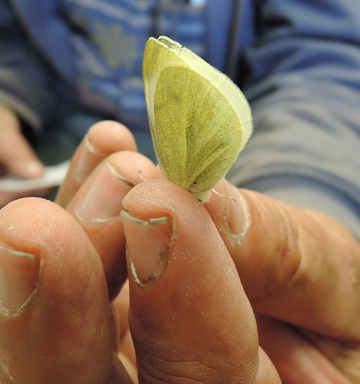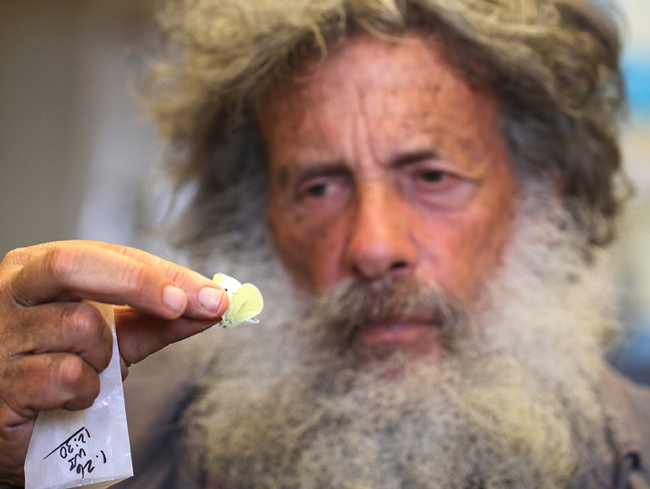
And we have a winner!
Drum roll...Art Shapiro...
Shapiro, distinguished professor of evolution and ecology at the University of California, Davis, who sponsors the annual Beer-for-a-Butterfly Contest to collect scientific data, snagged the first cabbage white butterfly of the year at 12:30 p.m.. Monday, Jan. 26 in West Sacramento, Yolo County.
“The cabbage white butterfly (Pieris rapae) finally came out today (Jan. 26),” he said.
And, it's a boy!
Shapiro figured this would be the day. Sunshine filtered through the high clouds in the morning, so it was relatively warm when Shapiro set out at 11.15 a.m. for a mustard patch near the railroad tracks. In fact, he was so “sufficiently sure” that Monday would be the day that he took his net “and was prepared to sweep the vegetation with it to kick up any individuals that were sunbathing (“dorsal basking”) in the dilute sunlight in order to raise their body temperature to the level needed for flight.”
But that wasn't necessary. “The sun came out strongly at 12.11 and the butterfly, a male, took wing spontaneously 19 minutes later,“ he related. ““It was a very easy catch; I suspect he emerged this morning (Jan. 26) and that was his first flight.”
Shapiro has sponsored the contest since 1972 to determine when the cabbage white will first emerge in the three-county area of Sacramento, Yolo and Solano. It's all part of his 43-year study of climate and butterfly seasonality. “It is typically one of the first butterflies to emerge in late winter.”
Although the first flight of the cabbage white has been as late as Feb. 22, it is emerging earlier and earlier as the regional climate has warmed, said Shapiro. “There have been only two occasions in the 21stcentury in which it has come out this late: Jan 26, 2006 and Jan 31, 2011.
“It's obvious that a dry January doesn't guarantee an early emergence!” Shapiro said. ”The very wet December of 2014 laid the groundwork for tule fog this month, which we hadn't really seen since the drought began. The cold, foggy weather certainly played a role in delaying emergence.”
Ten minutes after collecting the cabbage white, a second species, the mourning cloak (Nymphalis antiopa) showed up. “It hibernates as an adult and is always an early flier, but this was its first record on the floor of the Sacramento Valley this year—it's been out about two weeks in the lower Coast Range,” Shapiro said.
Five minutes later, at 12.45, a third species showed up: a male fiery skipper (Hylephila phyleus) that landed momentarily literally at Shapiro's feet. It was the earliest he's ever recorded. “This is a much more significant record than the others,” he said, explaining that the fiery skipper “normally is first recorded around here in March or even April. Last year it set a new early record in the Valley—Feb. 21, in Rancho Cordova, Sacramento County.—the only February Valley record in our 43-year database. It was last seen in 2014 on Dec. 1, also in Rancho Cordova. However, there are two January records at the Suisun Marsh, Solano County: Jan. 3, 1996 and Jan. 28, 2000.
Of the fiery skipper, Shapiro noted: “The first was certainly a late carryover of the fall 1995 brood, which was still flying on Dec. 14. “ The species wasn't seen again until the start of the spring brood on March 31, 1996. The 2000 record is more ambiguous. The last Suisun sighting in 1999 was on Dec. 11 and the first spring sighting was very late, May 24, 2000.
“The last fall-brood sighting of the fiery skipper was on Nov. 9, 2014, making it exceedingly unlikely that this was a late individual from that brood,” Shapiro said.
In 2014, Shapiro netted the winning cabbage white butterfly at 12:20 p.m. Tuesday, Jan. 14 in West Sacramento, Yolo County. It ranked as "the fifth or sixth earliest since 1972.”
Shapiro has won the contest every year except three. Graduate student Adam Porter defeated him in 1983; and graduate students Sherri Graves and Rick VanBuskirk each won in the late 1990s.
The contest rules specify that it be an adult (no caterpillars or pupae and that it be captured outdoors. It must be live when delivered to the department office, 2320 Storer Hall, UC Davis.
Shapiro has monitored central California's butterfly populations for 43 years and posts information on his website.
Attached Images:
